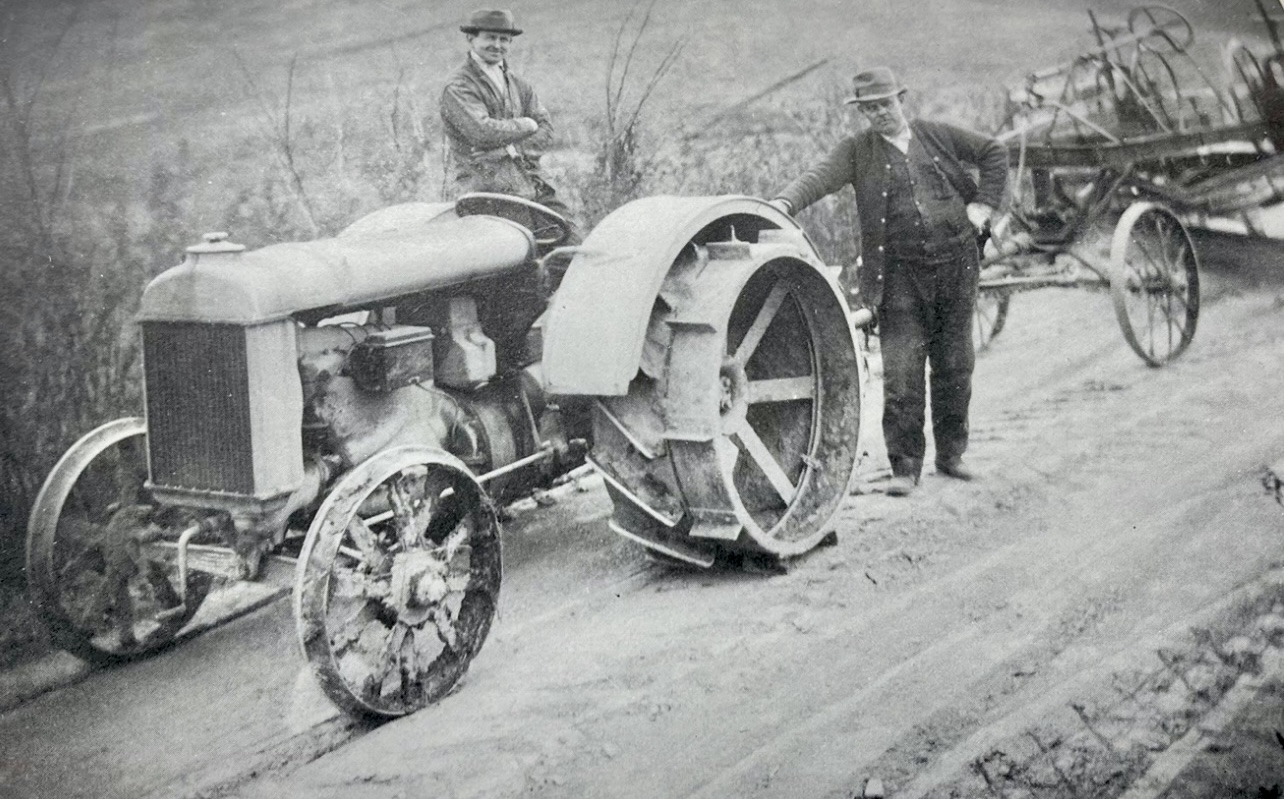I found this moment in time captured on page 892 of the History of Greene County by G. Wayne Smith. It offers a crisp glimpse of road maintenance, 1920s style. George W. Gordon is perched on a fender of an imposing steel-wheeled tractor and Bill Cummins leans a hand on the other. Behind them is the blade that flattens the ruts on dirt roads in preparation for a coating of chipped limestone, rock dust and a sticky binding agent generally known since the early 1800s as macadam. All that is missing from the name macadam is the capital A of John McAdam of Scotland who invented the process in 1822. Layers of crushed granite or limestone built the bed of the road, topped off with a layer of rock dust to shed water and sometimes bound with tars or oils for stability. When the push was on after World War I to make way for motorized vehicles, macadam roads became the specialty of township road supervisors, elected from the farm families who lived there and traveled the roads they maintained.
Mr. Smith doesn’t say what road George and Bill were working on when this shot was taken, but it’s a good guess that both of them lived nearby and most likely lived in the same township.
Were they township supervisors striking a happy pose beside a newly purchased piece of equipment?
Hard to tell, but the photo is dated as being taken sometime in the 1920s, a time when roadbeds were being strengthened and new rules of driving were being written in every municipality. Cars and trucks were vying for road space with horseback riders and buggy drivers and it was another culture shock moment in time.
Some of these culture shock moments made the local news.
When the road from Waynesburg to Carmichaels was opened in 1921, an ordinance in Jefferson required drivers to honk at all intersections. Officer Albert Hyatt chose a Sunday afternoon that October to station himself at the corner of Main and Pine streets and arrest more than 60 motorists for failing to obey. The fine was a whopping $5 but civic outrage saved the day. By Monday burgess Samuel J Fulton had returned the fines and overturned convictions on the grounds it was a first offense and unintentional. “Hyatt was later removed as a policeman for his overzealous enforcement…” the Waynesburg Republican gleefully reported.
Thanks to Dr. Smith’s microfilm snooping through old newspaper clippings, the folks who lived in the transformative 1920s come to life. Women now had the right to vote for the very first time in the local primaries of September 20, 1921 and vote they did. Voters had to be registered by July 20 and all taxes paid by Election Day. In the November general election Hester Frye won a seat on the Waynesburg School Board and Bertha Hanna was a duly elected county auditor.
Farming was still a mainstay of life for 80 percent of the families of Greene County and sheep were still the biggest agricultural crop. Wool produced in 1926 weighed in at 654,000 pounds and close to a million pounds by 1930.
By now most farmers had vehicles but only a few had tractors, so the gnarly tractor-pulled road grader in this photograph would have been a welcome sight after weeks of wet weather as farmers brought in their crops and got ready to drive them to market.
A quick study of the Caldwell’s Atlas maps of 1876 shows the family names of Gordon and Cummins marking farms in Whiteley Township so a good guess is George W. Gordon and Bill Cummins were working on one of the roads that linked their farms to the markets in Waynesburg, six or seven miles away.
It appears to be a sunny day, the road is well dressed and Gordon and Bill look pretty pleased with themselves. Is it early spring or late fall? Hard to tell, but the road sure looks good. You get the feeling that by July this country road will be well tended to as farmers spend long days in the field getting in the hay before the next bout of June into July rain comes thundering in. As every farmer knew then and still knows now – it most always rains on Rain Day, July 29.
